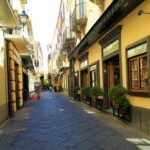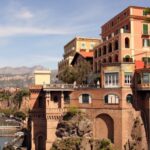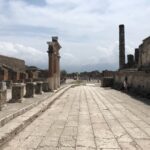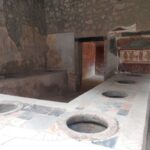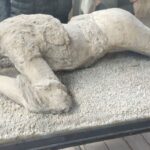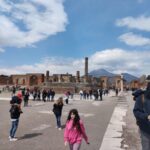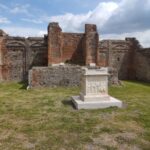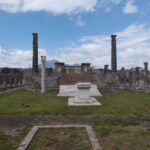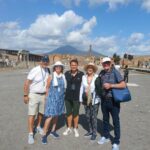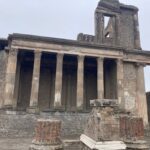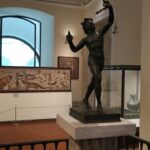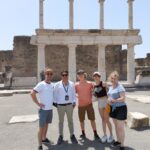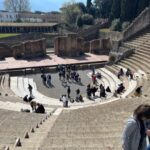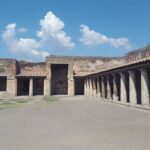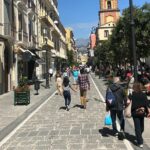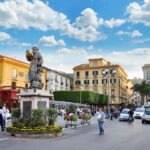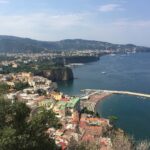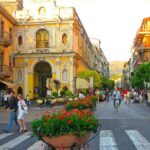Sorrento and Pompeii private shore excursion
One of the most famous italian towns and the best archaeological site of the world. Van driven by a professional driver
Being an archaeologist, I excavated a house in Pompeii with my university professor. An incredible experience that I will always carry with me. Pompeii for me is simply a magical place that will leave you with an unforgettable memory of how a Roman city was made in all its public, private, civil, and religious aspects.
Pompeii was an ancient Roman city located near modern Naples in Italy. Its history dates back to around the 7th century BC when it was founded by the Oscans, an Italic tribe. Initially, it was a small agricultural community, but it grew over time into a prosperous and bustling city, largely due to its strategic location near the Bay of Naples and its fertile volcanic soil.
The history of Pompeii:
Greek Influence: Before becoming a Roman city, Pompeii was influenced by Greek culture, as were many other cities in the region. The Greeks established trading posts in southern Italy, including Pompeii, which contributed to the city’s cultural development.
Roman Conquest: In the 5th century BC, Pompeii came under the control of the Samnites, another Italic tribe. However, by the 4rd century BC, it was absorbed into the expanding Roman Republic during the Samnite Wars. Under Roman rule, Pompeii flourished as a commercial and trading hub.
Prosperity and Urban Development: During the 1st century BC, Pompeii experienced a period of significant growth and prosperity. The city expanded, and many public buildings, temples, theaters, and lavish villas were constructed. Pompeii became a vibrant center of commerce, art, and culture.
Mount Vesuvius Eruption: One of the most significant events in Pompeii’s history occurred on August 24, 79 AD, when Mount Vesuvius, the nearby volcano, erupted catastrophically. The eruption buried Pompeii and several other nearby towns under a thick layer of volcanic ash and pumice, preserving them remarkably well for centuries.
Rediscovery: Pompeii remained buried and largely forgotten for centuries until its rediscovery in the 18th century. Excavations began in the mid-18th century and have continued to the present day, revealing invaluable insights into daily life in ancient Rome.
Archaeological Site: Today, Pompeii is an archaeological site of immense historical and cultural significance. It attracts millions of visitors each year who come to explore its remarkably preserved ruins, streets, buildings, and artifacts. Pompeii provides a fascinating glimpse into the daily life, architecture, art, and society of ancient Rome.
Overall, Pompeii’s history is a tale of prosperity, destruction, and rediscovery, offering a unique window into the ancient world.
My experience and my organization will allow you to visit two fantastic places allowing you to enjoy them without stress. A special and unique experience in the Gulf of Naples.
– Sorrento, a charming coastal town perched atop cliffs overlooking the Bay of Naples in southern Italy, is renowned for its stunning beauty and rich cultural heritage. Here’s a description of some of Sorrento’s most captivating features:
Breathtaking Coastal Views: Sorrento offers unparalleled vistas of the azure waters of the Tyrrhenian Sea and the rugged cliffs of the Sorrentine Peninsula. The panoramic views from the town’s elevated position are truly breathtaking, especially during sunrise and sunset when the sky is painted in hues of pink and gold.
Historic Old Town: The heart of Sorrento is its historic Old Town, characterized by narrow cobblestone streets, quaint alleyways, and colorful buildings adorned with cascading bougainvillea and jasmine. Strolling through the labyrinthine streets, visitors encounter charming cafes, artisan workshops, and family-run trattorias serving authentic Neapolitan cuisine.
Piazza Tasso: The bustling Piazza Tasso serves as the vibrant hub of Sorrento’s social and cultural life. Named after the renowned poet Torquato Tasso, who was born in Sorrento, the square is lined with cafes, shops, and gelaterias. It is the perfect spot for people-watching and soaking in the lively atmosphere.
Citrus Groves and Lemon Terraces: Sorrento is famous for its fragrant lemon groves and terraced gardens, where the prized Sorrento lemons are cultivated. These terraces, known as “giardini di limoni,” dot the landscape, filling the air with the sweet scent of citrus blossoms. Visitors can explore the groves and even sample limoncello, a traditional lemon liqueur made from locally grown lemons.
Breathtaking Clifftop Villas: Perched atop the cliffs overlooking the sea, Sorrento boasts several magnificent villas and palaces that offer a glimpse into its aristocratic past. Villa Comunale, a lush park adorned with statues and fountains, provides an idyllic setting for leisurely strolls and picnics, while Villa Fiorentino hosts cultural events and exhibitions.
Artisanal Crafts and Souvenirs: Sorrento is renowned for its artisanal crafts, including intricate woodwork, inlaid intarsia, and handmade ceramics. Visitors can browse the shops along Via San Cesareo, the town’s main thoroughfare, to find unique souvenirs and gifts to take home.
Cultural Heritage and Museums: Sorrento boasts a rich cultural heritage, with traces of its Greek, Roman, and medieval past evident throughout the town. Visitors can explore historical sites such as the ancient Roman ruins of Villa Pollio and the Duomo, Sorrento’s stunning cathedral housing beautiful frescoes and marble sculptures. The Correale di Terranova Museum showcases a rich collection of art and artifacts, offering insights into Sorrento’s artistic legacy.
In summary, Sorrento captivates visitors with its natural beauty, historic charm, and vibrant culture, making it a must-visit destination on any itinerary to the Amalfi Coast. Whether admiring the panoramic views, savoring local delicacies, or exploring its cultural treasures, Sorrento offers an unforgettable experience that lingers in the hearts of travelers long after they depart.
The tour lasts about 2 hours, during which we will visit the historic center and upon request.
MEETING POINT + TOUR DURATION
Meeting Point Options: Rail or Bus Station, Cruise Ship Port, Airport, Hotel of Naples or the surrounding area up to Sorrento.
Duration: 6 hours
1 hour is generally for the lunch.
ITINERARY
– The tour in Pompei lasts about 2 hours.
– The tour of the museum lasts about 1 hour and 30 minutes.
– Private trasportation by taxi roundtrip from your hotel/address.
In Pompei:
– The Big Theatre
– The Small Theatre
– At the bakery shop
– The house of the Ceii
– The house of the Menander
– The main street named Abbondanza street
– A Roman fast food
– The Stabian bathhouse
– The brothel
– The main square
– The Macellum and the plastercasts of the victims
•The order might change
In the MANN:
There are different sections in the Museum and I will illustrate the most significant masterpieces underlining their period, production techniques, anecdotes and historical curiosities of the figure represented. The itinerary includes visits to the following sections:
– FARNESE SECTION
– MOSAICS SECTION
– SECRET CABINET
– SECTION OF THE VILLA OF THE PAPYRS
– SUNDAY HALL
– SECTIONS OF DAILY LIFE OBJECTS
– FRESCOES SECTION
– CORK PLASTIC OF POMPEII FROM 1800
This tour can be customized
WHAT’S INCLUDED
- Guiding Service
- Private trasportation
ESTIMATED LOCAL CASH NEEDED
18 € – admission fees to enter in the ruinsof Pompei,
22 € for National Archaeological Museum; prices are per person.
Under 18 years old are free of charge.
WHAT’S EXTRA
- Meal


